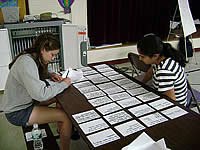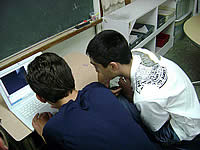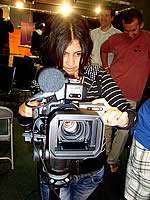
WAITSFIELD, VERMONT--Armenian and Azerbaijani youth typically don’t have much in common, aside from their mutual feelings of mistrust. For years, they have seen their countries in violent conflict over the Nagorno-Karabakh territory. But with the help of a program funded by the U.S. State Department, some of these young people have come together around a shared interest: using film and social media to create social change.
The program, Developing Online Tools for Civic Outreach and Mobilization (DOTCOM), is run by Project Harmony International. Based in Vermont, it connects high schoolers from the U.S., Armenia, and Azerbaijan.
DOTCOM’s first goal is to teach these young people to harness film and social media to address social issues and effect change. Just as important, the program hopes to begin to resolve conflicts among Armenian and Azerbaijani youth.
The first goal saw ready success. The program’s 90 youth participants learned effective methods of communication, posted short films, and blogged about social issues that are important to them. At a four-week summer 2009 conference in Washington, D.C. and Vermont, 30 of them--10 from each country--received a crash course in filmmaking. Each student received a Flip camera to use at the conference and then bring back home to continue making films. In small groups, the students created short public service announcements (PSAs) about social issues including children’s rights, media censorship, and the environment.
The challenges of conflict resolution
Whether the program achieved its goal of conflict resolution is “less definite,” according to Katie, one of the American participants. 
The territorial conflict between Armenia and Azerbaijan has rendered dialogue between citizens of the two countries “legally impermissible and socially objectionable,” according to DOTCOM program director Elizabeth Metraux. “It’s been an enormous challenge to get students talking and to break down those hugely embedded stereotypes of the other,” she said. At the beginning of the conference, she noted, some of the Armenian and Azerbaijani students would not even make eye contact with each other.
Tessa, another American participant, was initially surprised that dialogue between the Armenian and Azerbaijani youth proved so difficult. The conference pushed her and a number of other American students, she said, to analyze their idealistic views of overcoming conflicts. Reality, she concluded, was “far from, ‘Oh, we can dance around and be happy together!’”
“We kind of agreed not to talk about the [territorial] conflict,” said Katie. “It was kind of put on the back burner.”
Talking and blogging about the conflict was not just difficult, but potentially dangerous. While the students were at the July DOTCOM conference, two young bloggers were detained in Azerbaijan for speaking out against the government.
“There are so many topics that we can’t officially discuss or run an assignment on, in terms of responding to certain political questions,” Elizabeth Metraux explained. “You want to encourage that kind of discourse on political issues. But you really have to measure that against the reality that the government is certainly not opposed to throwing people in jail, regardless of their age.”
Discovering common ground
 During the conference, Tessa said, “The goal became just being able to talk to each other and [find] our similarities.” Working together on films was the perfect way to foster a dialogue based on common ground. “I don’t think that any other form would have been able to create the kind of environment that we had when we were making films,” she said. “With a group of three, you formed really close relationships. Students who are technically in conflict with one another are interacting, thinking about ‘what picture should I put here?’ and ‘how can I edit here?’”
During the conference, Tessa said, “The goal became just being able to talk to each other and [find] our similarities.” Working together on films was the perfect way to foster a dialogue based on common ground. “I don’t think that any other form would have been able to create the kind of environment that we had when we were making films,” she said. “With a group of three, you formed really close relationships. Students who are technically in conflict with one another are interacting, thinking about ‘what picture should I put here?’ and ‘how can I edit here?’”
Concentrating on the social issues their PSAs addressed allowed the students to discuss other issues that crossed their political dividing lines. (Click here to watch Tessa’s PSA about children’s rights.)
“It’s the idea of forgetting the really big problem and focusing on other issues,” Katie said. “Like gender issues, which is pretty important because they have very ingrained gender roles [in the Caucasus].”
Getting such matters out in the open helped participants cross personal boundaries, too. “They found that they can agree on that issue and make a film about it together,” added Katie. “This made the other side a real person ... rather than an enemy they’d heard about.”
Keeping the conversation alive
After they left the first conference, Katie said it was easy for the Armenians and Azerbaijanis to avoid contact with one another and forget the progress they had made. But the 30 student filmmakers will meet again this April, when the will travel to the South Caucasus for their second and final conference. In addition to interacting with prominent bloggers and journalists in Armenia and Azerbaijan, they will participate in the 2010 Social Media for Social Change conference in Tbilisi, Georgia.
The DOTCOM program, which began in October 2008, will come to an end in June 2010, after this conference. And if the conflict between the Armenians and Azerbaijanis is ever going to end, Katie believes, more programs like it are needed.
“I think that the conflict can be solved only with the youth of the two countries, not with third-party involvement with the U.S. [government] trying to moderate talks,” she said. The real obstacle, she asserted, was animosity on the part of the public, and so programs that bring people together offer the most hope for improving relations across the borders.




